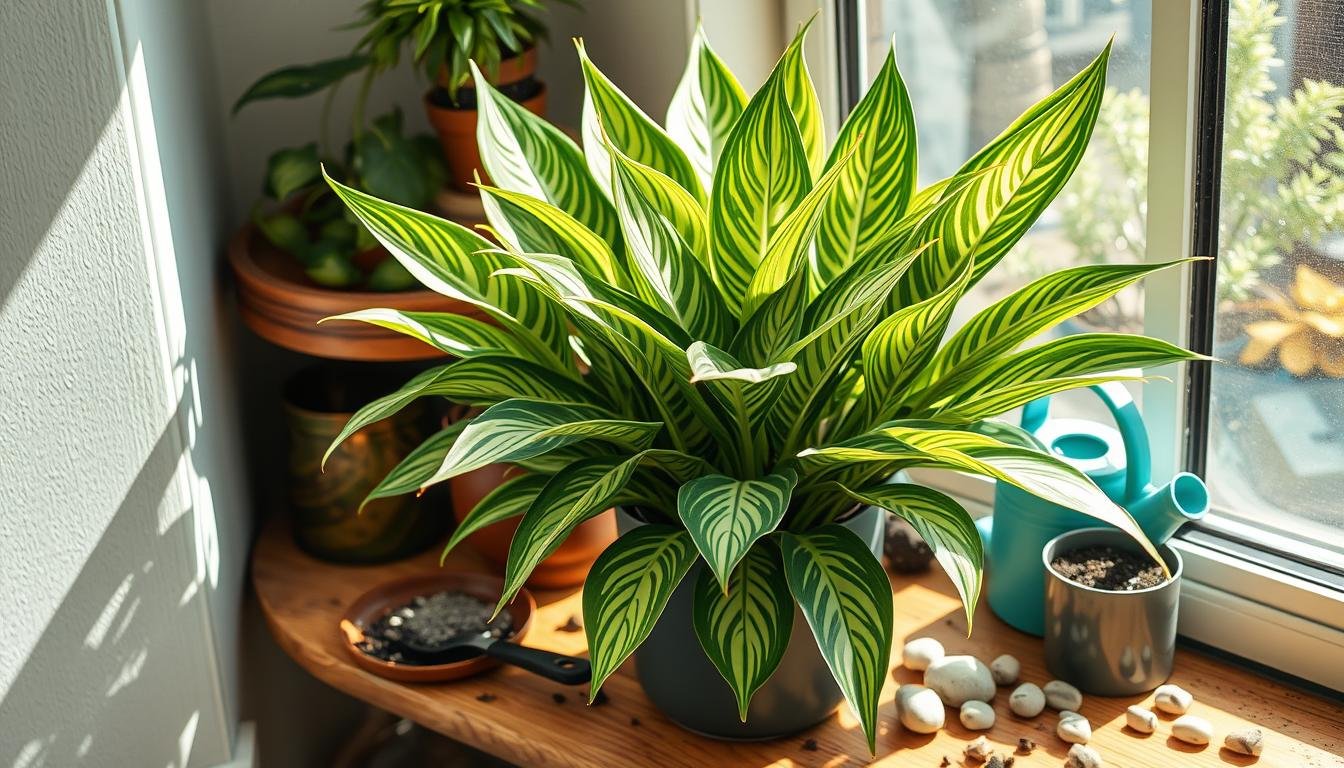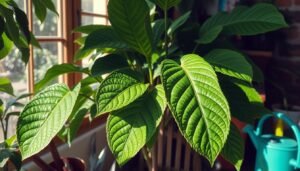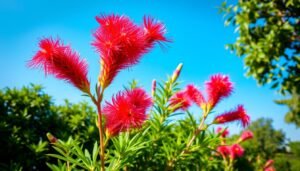The zebra plant, known as Aphelandra squarrosa, is a beautiful indoor plant. It has dark green leaves with white stripes and bright yellow flowers. Many people want to keep this plant healthy and blooming.
But, zebra plant care can be tricky. Knowing what it needs is key to growing a thriving plant. It comes from Brazil’s humid, warm areas. It needs high humidity, well-draining soil, and bright, indirect light.
By following the right care, your zebra plant can live up to 10 years. It will be a wonderful addition to your home for a long time.
Table of Contents
Introduction to the Zebra Plant
The zebra plant, known scientifically as Aphelandra squarrosa, is famous for its unique striped leaves and occasional blooms. Its dark green leaves have bold white veins, adding beauty to any room. Zebra plants can grow from 1 to 6 feet tall, depending on the light and care they get.
Knowing where the zebra plant comes from is key. It thrives in warm climates, like Brazil. This knowledge helps us create the right conditions for it to flourish indoors.
For a zebra plant to thrive, it needs the right care. It loves bright, indirect light and well-draining soil. If you’re growing it outdoors, places like Florida or Southern California are perfect. Indoors, make sure it gets enough nutrients every month with a general-purpose fertilizer.
Understanding Zebra Plant Care
Caring for your zebra plant means knowing what it needs. Success comes from meeting these needs and understanding its unique traits. This makes it a standout houseplant.
Essential Care Requirements
Zebra plants need certain conditions to thrive. They love high humidity, around 60-70%. But they can handle lower levels too. Keep the temperature between 65°F and 75°F for best growth.
Watering is key, but be careful not to overdo it. Too much water can cause yellow leaves and root rot. Let the soil dry out completely before watering again. A moisture meter can help you know when it’s time.
- Humidity: 60-70% preferred, with tolerance down to 30-40%
- Temperature: 65°F to 75°F optimal range
- Watering: Generous watering until it drains, then wait until the top inch of soil dries
Overview of Plant Characteristics
The zebra plant has unique features that make it eye-catching. Its thick, dark green leaves with white spots add beauty to any room. It grows up to 8 inches tall indoors, but can reach 2 meters outside.
In good light, it shows off its bright red and orange colors. But remember, it’s toxic to pets if they eat it.
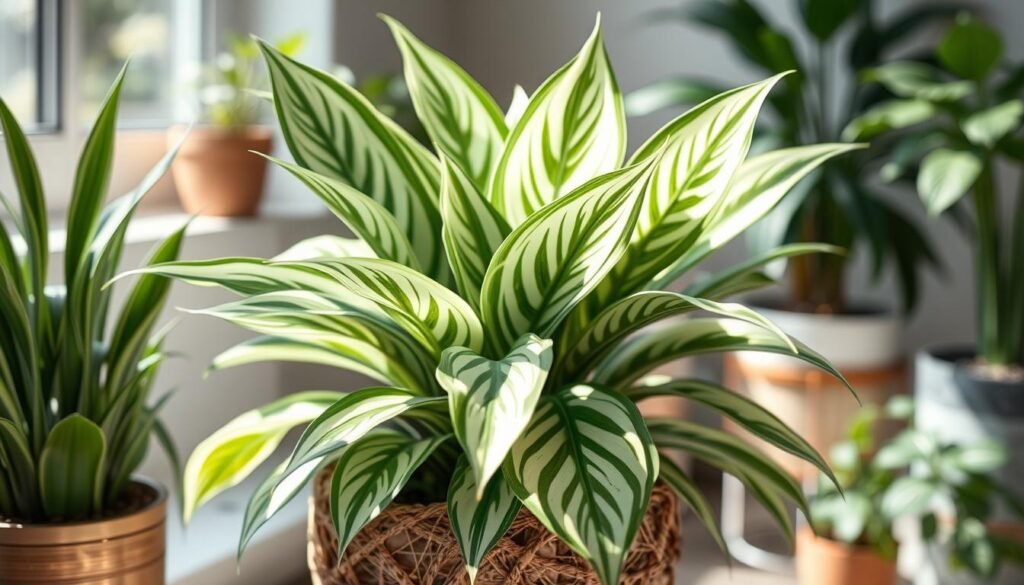
| Requirement | Ideal Setting | Notes |
|---|---|---|
| Humidity | 60-70% | Tolerates low humidity (30-40%) |
| Temperature | 65°F – 75°F | Avoid temperatures below 50°F |
| Watering | When the top inch of soil is dry | Overwatering leads to yellowing and mushy leaves |
| Light | Bright, indirect light | Avoid direct sunlight, specially in the afternoon |
Zebra Plant Light Requirements
Knowing what light your zebra plant needs is key to its health and beauty. It loves bright, indirect sunlight, just like its natural home. The right light helps it grow and bloom, and keeps it safe from light problems.
Optimal Light Conditions
Zebra plants do best in bright, indirect light. East or west-facing windows are perfect spots for them. They can also do well in medium to low light, making them great for many rooms.
For the best growth and color, give them 4 to 6 hours of bright light a day outside. Morning light is good, but too much afternoon sun can burn their leaves.
Avoiding Light Damage
It’s important to protect your zebra plant from too much light. Too much direct sun can make their leaves dry and change color. To avoid this, keep them away from harsh sunlight and watch for signs of stress.
If you see any problems, moving the plant to a better spot can help it get back to health.
| Light Condition | Recommended Exposure | Potential Issues |
|---|---|---|
| Bright, Indirect Sunlight | 4-6 hours daily | Healthy growth, vibrant colors |
| Medium Light | 4-6 hours daily | Stable growth with less vibrancy |
| Direct Afternoon Sunlight | Avoid | Leaf scorching, dry tips |
Zebra Plant Watering Needs
Proper watering is key for your zebra plant’s health. Knowing its specific needs helps you give it the right moisture. Finding the right balance is vital to avoid problems from too much or too little water.
Watering Frequency and Techniques
The zebra plant does best with medium watering. Water it when the top 25% of the soil feels dry. For a 5-inch pot, about 0.5 cups of water every nine days is good, under indirect light.
Using a consistent watering method keeps the moisture just right. This helps your plant grow strong and healthy.
Signs of Overwatering vs. Underwatering
It’s important to watch for signs of overwatering. Look for yellow leaves, a droopy look, and root rot if it’s not fixed fast. On the other hand, underwatering shows as dry, crispy leaves and wilting.
By keeping an eye on your plant, you can fix these problems quickly. This keeps your zebra plant happy and healthy.
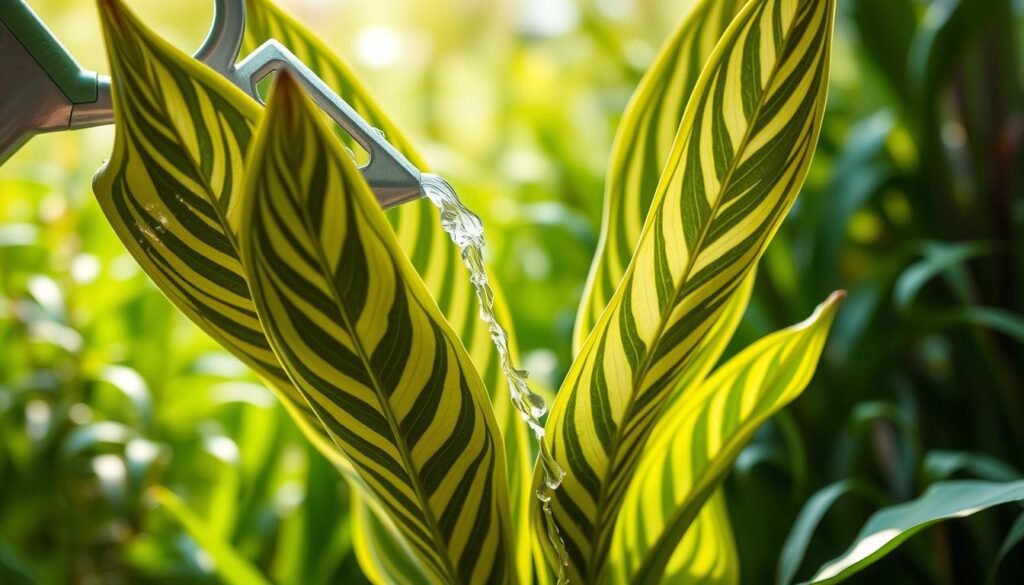
| Watering Condition | Signs | Suggested Action |
|---|---|---|
| Overwatering | Yellow leaves, drooping | Allow soil to dry out; reduce frequency |
| Underwatering | Dry, crispy leaves, wilting | Increase watering frequency; ensure thorough soak |
Zebra Plant Soil Preferences
Knowing what soil your zebra plant likes is key to keeping it healthy. These plants do best in certain soils that help them grow. The right mix and conditions mean your zebra plant can thrive.
Soil Types for Optimal Growth
Zebra plants need a soil mix that holds moisture but also drains well. A mix of peat-based potting mix and African Violet soil works great. This blend keeps the soil moist and well-aired, helping the roots grow strong.
Importance of Drainage
Good drainage stops water from pooling, which can cause root rot. Make sure your pot has holes for water to drain. Check the soil’s moisture often to water right, avoiding too much water.
| Soil Component | Function |
|---|---|
| Peat-Based Mix | Moisture retention |
| African Violet Soil | Good aeration |
| Sand Addition | Improves drainage |
Following these tips on soil types and drainage will help your zebra plant grow well. It will make your indoor garden look great and keep your plant healthy.
Zebra Plant Temperature Tolerance
The health of your zebra plant depends on its temperature tolerance. Knowing the ideal temperature range is key for your plant’s growth. Keep your zebra plant between 65°F and 75°F (18°C to 24°C) for the best results.
Temperatures below 60°F can cause leaf loss. On the other hand, temperatures above 75°F can stress your plant. Understanding these factors is vital for preventing temperature stress.
Ideal Temperature Range
For a healthy zebra plant, a consistent environment is essential. Here’s a quick guide to ideal and extreme temperatures:
| Temperature Condition | Impact on Zebra Plant |
|---|---|
| 65°F – 75°F | Optimal growth and health |
| Below 60°F | Leaf loss and stress |
| Above 75°F | Stress and possible growth stunting |
Avoiding Temperature Stress
To protect your zebra plant from temperature stress, avoid cold drafts or air conditioning vents. Temperature changes can harm bloom quality and cause stress signs like droopy leaves or color changes.
Adjusting room temperature slowly and moving the plant helps. Aim for humidity levels between 50% and 60% and stable temperatures. This will keep your zebra plant healthy and vibrant.
Zebra Plant Humidity Levels
Keeping the right humidity is key for a zebra plant to thrive. They do best in humid environments, between 50% and 60%. Even though they can handle typical room humidity, too little can cause problems like brown leaves or slow growth. Knowing how to keep the humidity right helps your zebra plant stay healthy and bright.
Maintaining Optimal Humidity
Here are some ways to keep your zebra plant’s humidity just right:
- Misting: Mist the leaves lightly often to make the air more humid.
- Pebble Tray: Put a tray with pebbles and water under the pot. As the water evaporates, it adds moisture to the air.
- Grouping Plants: Putting your zebra plant with other plants can make a humid spot.
- Humidifiers: Use a humidifier in the room, mainly in dry winter months, to keep humidity up.
Methods to Increase Humidity Indoors
Here are some ways to boost humidity for your zebra plant:
- Check humidity levels often with a hygrometer.
- Move the plant to a humid spot, like a bathroom or kitchen.
- Add indoor water features, like fountains, for more moisture.
Zebra Plant Fertilization Techniques
Knowing how to fertilize your zebra plant is key to its health and beauty. The right fertilizer and how often to use it greatly affect your plant’s growth. In spring and summer, a special care routine will help your plant grow lush and bloom.
Recommended Types of Fertilizer
There are many fertilizers for your zebra plant, organic and synthetic. Here are some top picks:
- Organic Fertilizers: Espoma Organic Flower-tone is high in phosphorus, great for blooms.
- Synthetic Fertilizers: A 20-20-20 mix is quick to absorb and boosts blooms.
- Micronutrients: Iron and zinc are vital for your plant’s health in small amounts.
Fertilization Frequency
Fertilizing your zebra plant right is important. In the growing season, fertilize every 1-2 weeks to encourage blooms. When your plant is dormant, stop fertilizing to avoid soil nutrient buildup.
| Season | Fertilization Frequency | Type of Fertilizer |
|---|---|---|
| Spring | Every 1-2 weeks | Organic or Synthetic |
| Summer | Every 1-2 weeks | Organic or Synthetic |
| Fall | As needed | Avoid Fertilizing |
| Winter | Avoid Fertilizing | Avoid Fertilizing |
When fertilizing, spread it evenly around your plant to avoid harming roots or leaves. If your plant shows signs of too much fertilizer, like discolored leaves, act fast. Rinsing the soil with water can help fix this problem.

Zebra Plant Pruning Techniques
Pruning your zebra plant is key to keeping it healthy and looking good. The right pruning techniques encourage growth and improve air flow. Knowing when to prune and using the right tools keeps your plant happy and thriving.
When to Prune Your Zebra Plant
The best time to prune your zebra plant is in late winter to early spring. This is when it starts growing again and is ready for pruning. Don’t cut too much, as this can stress the plant. A little pruning goes a long way.
Tools for Effective Pruning
Choosing the right pruning tools is important for your zebra plant’s health. Always use a sharp pruner for clean cuts. Dull tools can harm the stems and lead to disease. After pruning, water carefully to prevent root rot. Make sure the soil is dry before watering again.
| Pruning Timing | Recommended Tools | Post-Pruning Care |
|---|---|---|
| Late Winter to Early Spring | Sharpened Pruners | Water Sparingly |
| Avoid overzealous cutting | Clean Blades | Ensure soil dries before next watering |
Zebra Plant Repotting Guide
Repotting a zebra plant is key to its health and growth. Knowing when and how often to repot helps your plant thrive for years.
Signs That Your Plant Needs Repotting
There are clear signs your zebra plant needs a new home. Look out for these:
- Roots emerging from the drainage holes.
- Stunted growth despite good care.
- Top-heavy appearance, causing the plant to topple over.
Acting on these signs quickly ensures your plant grows well.
Repotting Frequency and Best Practices
Zebra plants usually need a new pot every two to three years. Follow these tips for successful repotting:
- Choose a pot that is 1-2 inches wider in diameter than the current one.
- Opt for terracotta or unglazed ceramic pots for better air and moisture circulation.
- Plastic pots are good if you often forget to water, as they hold moisture longer.
- Spring is the best time to repot, matching the plant’s growth cycle.
- Water the plant more after repotting for a few weeks to help it adjust.
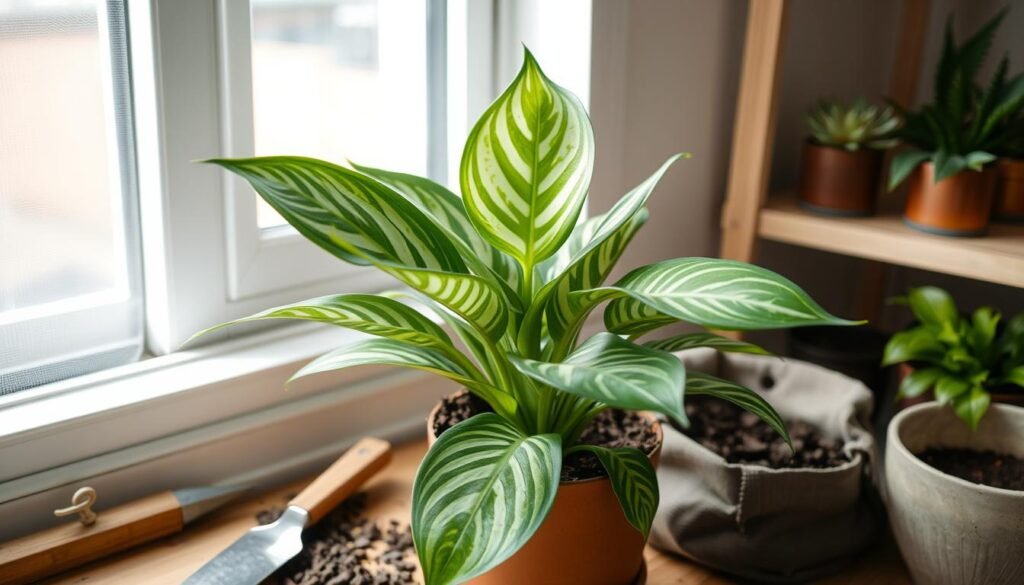
By watching for these signs and following repotting advice, you’ll create a great environment for your zebra plant to grow.
Zebra Plant Propagation Methods
Learning about zebra plant propagation can make gardening more fun. You can grow more plants or share them with others. This part will cover stem cuttings and how to care for new plants.
Stem Cuttings for Propagation
Stem cuttings are a top choice for zebra plant propagation. Pick healthy stems in spring or early summer. Cut 2-3 inches off and use rooting hormone for faster roots.
Put the cut ends in water or moist soil. Keep the soil moist but not too wet. This helps the roots grow well.
Care for New Propagated Plants
Once your cuttings have roots, it’s time to care for them like mature plants. Watch the water closely to avoid root rot. Feed them regularly during the growing season.
- Let the new plants get used to their new home slowly.
- Give them bright, indirect light for growth.
- Check for pests or signs of stress often.
Zebra Plant Pest Control
The zebra plant is known for its striking leaves. But, it can attract pests. It’s important to watch your plant closely for any signs of pests. Keeping your plant healthy helps prevent pests and keeps it thriving.
Common Pests Affecting Zebra Plants
Zebra plants face several pests that can harm them. These pests include:
- Aphids – These tiny insects can cause yellowing leaves and attract ants with their honeydew.
- Spider Mites – These pests cause speckling and discoloration on leaves, indicating severe damage.
- Mealybugs – They leave a sticky residue on leaves, which can lead to sooty mold.
- Fungus Gnats – They prefer moist conditions and target roots, harming young plants.
- Scale Insects – These pests can cause yellowing and stunted growth if not treated quickly.
- Thrips – Known to stunt growth and leave silvery streaks on leaves.
Treatment Options for Infestations
There are several ways to control pests on zebra plants. Catching pests early is key to preventing infestations. Here are some options:
- Insecticidal Soap – A safe choice to eliminate many types of pests while being gentle on your plant.
- Neem Oil – A natural method that disrupts the lifecycle of pests without harming beneficial insects.
- Sticky Traps – Useful for monitoring and reducing pest populations.
- Water Management – Water zebra plants only when the top inch of soil is dry to deter fungus gnats.
- Quarantine New Plants – This prevents pests from spreading to your existing plants.
Keeping your zebra plant stress-free helps it fight off pests. Make sure it has the right light, humidity, and temperature. Also, keep its leaves clean and dust-free to discourage pests.
Conclusion
Caring for a zebra plant requires knowing its special needs. This is key for keeping your houseplant healthy. Make sure it gets the right light and water it carefully. This plant likes dry soil.
It needs about 0.5 cups of water every 12 days, unless it’s in direct sunlight. This makes it easy to care for, even if you’re new to gardening.
Keep the humidity up and the temperature between 60 to 70°F. Your zebra plant will grow well and might even bloom. The main thing is to be consistent with your care.
This will help your zebra plant show off its beautiful leaves and flowers. It’s a striking houseplant that adds life to your home.
Learning about your zebra plant’s needs can make your home feel like a lively oasis. With the right care, you’ll enjoy having this beautiful plant in your home for years.

